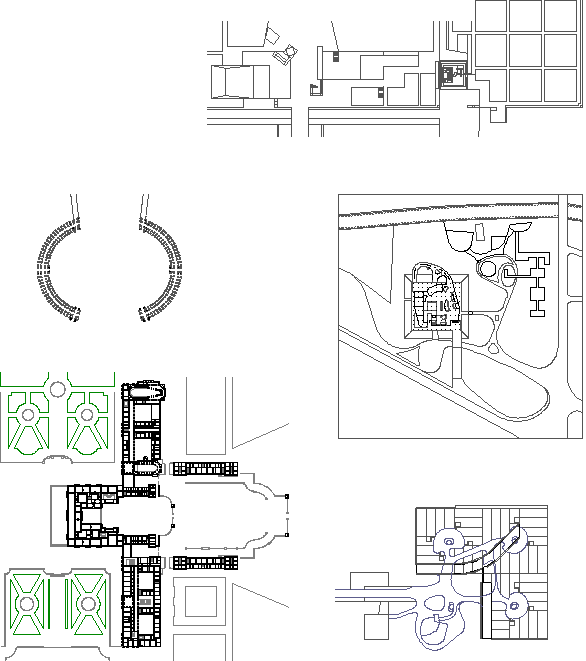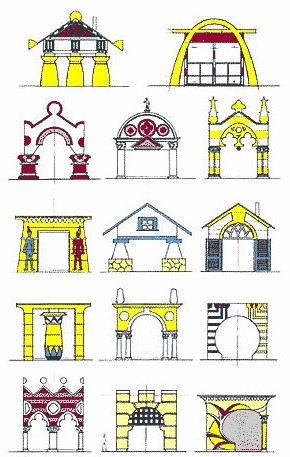2008.10.25 12:26
front-line ideas + regional tradition = potential for a design culture of thinking/making?
Regarding Jarzombek's "Un-Messy Realism", what's important comes at the end:
"We have to realize that our discipline is undergoing an inner transformation of historical import and that sooner or later it will yield an educational system far different from the one we grew up with in the last twenty years. But whether this is for better or worse is difficult to ascertain since there is also a collusion of silence in academe about where the ghost ship is heading."
The "collusion of silence", like a law of silence (utilized by various emperors) is an effective form of control.
More likely it is an outer transformation that is bringing about the inner transformation.
A "collusion of silence" can also breed ignorance via ignoring.
"Official art culture is much more effective in its control of history than Republican strategists, for it knows that the best way to treat contradictory material is not to rail against it, but simply to pretend it didn't happen."
--Mike Kelley, 1992
Be watchful of the inner and the outer to see the full picture.
2008.12.03 00:44
where is the good new architecture?
Is there really all that much difference between 31 December 1999 and 1 January 2000? They're arbitrary place setters, and not the demarcation of disticnt different times. Metaphorically, the calendar is the cart, not the horse.
Personally, I see the Seattle Library design going back to Kahn's [and Tyng's] mid-1950s Municipal Building designs for Philadelphia. Historical analysis within a space-time continuum is more ongoing productivity and less end-product.
2008.12.03 01:50
where is the good new architecture?
I prefer to watch architecture history as it actually unfolds, and not through the aperture of somewhat artificial markers.
2008.12.03 08:00
pragmatists turning political?
I listened to most of the lecture while doing other work. Interesting, and likely even fruitful, typological analysis in terms of forms and how they may relate to programs and usage, but there remains the hint of force-fit and an even horizontal shift from 'iconic' analysis/design to 'political' analysis/design. As to this work's place within the continuum, I like how this is now being reenacted.
2008.12.03 11:23
where is the good new architecture?
There may be well be a lot of recent built architecture that is uninteresting (to you), but, nonetheless, there is a lot of recent designed architecture that is interesting. I can hear you say that designed, i.e. unexecuted, architecture does not count on this list. Yet I can also hear you say that St. Pierre does not count because it was designed in 1962. That is to say I sense your evaluation process unfortunately includes a double standard. Not all architecture has to be built in order for it to be historically significant.
| |
2008.12.14 10:40
Shape and Form
Louis Sullivan's form follows function argued against architecture's form having become too removed from its function--banks shouldn't look like ancient temples; bankers don't wear togas. When Sullivan was in Philadelphia working at Frank Furness' office, 1872-73, it was on the same block as, if not right across the street from, William Strickland's Second Bank of the United States, with very severe Doric temple fronts, 1819-24. Strickland's Philadelphia architecture was meant to represent the United States as the new democracy, thus emulating (reenacting) the architecture of the old democracy of ancient Greece. Note, however, the similarity of the contemporaneous works of Strickland and Schinkel point to other factors also being present within the formulation of Strickland's style, likely the influence of the "Grand Durand".
4703
2008.12.31 09:38
pragmatists turning political?
The concluding 'Architecture' section of Aureli's "Toward the Archipelago" begins with:
"Let's immediately state that today's iconic building--the building that affirms its own singular presence through the appearance of its image, and that today constitutes one of the primary expressions of architectural culture at the scale of the city--cannot be a valid part of the city. Putting aside moral problems, issues of taste, and the gratuitous character of their forms, the iconic building cannot be considered an exemplary part of the city because its economic principle is to be unique and nonrepeatable."
This may well be what spurred Zaera-Polo's "The Politics of the Envelope".
[What works for me is...] Mixing Aureli's "The political ... indicates the possibility of conflict and as such calls for its resolution" and Zaera-Polo's "For architecture ... to convey that tendencies in the articulation of the building envelope capture the new political affects, to communicate that certain manipulations of the ground and the roof indicate the politicization of nature, or to explain the breakdown of the correlation between interior and exterior and private and public, are legitimate political performances."
Are ZP's categories of the envelope an attempt at repeatable icons?
ricochet:
brise-soleil: the politics of sun breaking
--Le Corbusier
--Kahn at Philadelphia Psychiatric
--Venturi at Frankfurt Arts & Crafts
houses under a common/detached roof
-- Plecnik
-- Le Corbusier
-- Krier at La Villette
osmotic architecture
-- Pantheon
--Versailles Hall of Mirrors
-- Altes Museum
-- Kimbell Art Museum
hyper envelopes of UN Studio
--Arnheim Central
--Architecture Faculty Venice
--Music Faculty Graz
| |
2009.03.16 11:28
Venturi's Lieb (No. 9) House to be moved (or demolished)
Historical analysis within a space-time continuum is more ongoing productivity and less end-product.
"architectures in the space-time continuum"
architectural history in the space-time continuum
Pergamon, wo bist du?
I'm beginning to wonder which is more immovable, a building or an opinion.
"[This museum should be regarded as a kind of reliquary containing various mementoes symbolizing not only the eternal brother-conflict, but also the military and diplomatic encounters, exchanges and betrayals of recorded history.] An old woman conducts a party through the museum, pointing out relics from the battle career of her hero Wellington, the Iron Duke. There are exhibits under glass and pictures on the walls. A flag, a bullet, a military hat; Duke Wellington on his big white horse; three soldiers crouching in a ditch; a pair of Naopeon's jinnies, making believe to read a book of strategy; and a sex-caliber telescope through which the Duke trains on the flanks of the jinnies."
JC&HMR
2009.03.17 17:02
pragmatists turning political?
Oh, I thought it was more like having a hard time shifting out of bilocation gear.
Anyway, been meaning to interject a little exposition of the "politics of the plan".

| |
2009.03.17 17:10
Making it/Thinking Architectural
architectural history flattened

architectural history reduced to a few lines
2009.08.16 12:01
Postmodernism sucks... discuss
...where we see Postmodern architecture related to the growing trend of realism in film (including cinematic pornography). Not exactly a parallel development, but more where realism in films opened up designers/architect's minds to a more realistic approach to designing buildings/environments. Prior to realism, most films were an adapted form of theater/stage production. Realism in film presented 'real' situations within 'real' settings. [Yes, there is the omnipresent irony of films themselves not being real to begin with.]
aside: Does anyone else remember the paparazzi catching Jackie O. after she saw I am Curious (yellow).
Outside the stage directions of the Modern Movement there is the quickly found serendipity of everyday living/experience, and this realm of no clear rules beyond the immediate context of the situation made it easy for (what Portoghesi called) 'the end of prohibitionism'.
Postmodern architecture would not have happened without a certain frame of mind, and that frame of mind was becoming more and more prevalent within films of the later 1960s and 1970s.
Strictly within architecture itself, Scully, in 'How things got to be the way they are now', finds the genesis of Postmodern architecture with Kahn and Kahn's Beaux Arts education and Roman-ness (wrapped together via Piranesi's plan of the Campo Marzio).
It seems worth noting that the two most significant architects to come out of the 'Strada Novissima' are Frank Gehry and Rem Koolhaas/OMA.
|